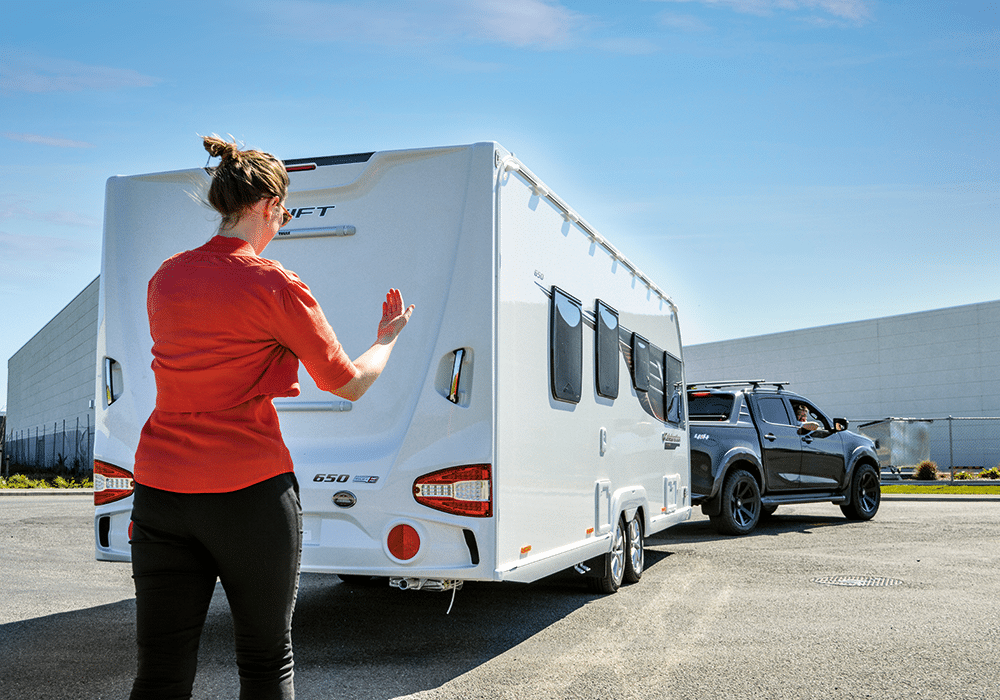A mistake when backing is easily made, and often very expensive. Here’s how to avoid a mishap that could ruin your holiday before it even begins.
Ever started to reverse your RV only to discover the fence post was closer than you realised, or that the nose of your motorhome was about to hit the side of the house? Don’t feel too bad – it happens more often than you might expect. In fact, the team at Covi NZMCA Insurance deal with more reversing accidents than any other avoidable claim.
Thankfully, more often than not you can avoid reversing accidents with adequate care and diligence, and having a few key tools in your ‘reversing toolbox’. One of the easiest things you can and should do is to complete thorough safety checks before you even start reversing.
“If there was one tip I could give people, it’s get out and see what’s behind you,” says Daryl Muir, owner of reversing camera supplier RSE NZ Ltd. “Having good quality and correctly placed visibility aids is vital, but it’s important to remember the basics and to have a quick look at your environment first. But bear in mind, even after checking, someone can still enter into your space either on foot or in another vehicle.”
It’s ideal to have a spotter guiding you as you reverse. And it pays not to overestimate your ability to reverse safely in a tight space. Take your time and move slowly and safely. Listen to your gut if you don’t feel confident and need to politely ask someone to move their vehicle slightly, to allow you more room. Better safe than sorry!
REVERSING CAMERAS
In instances where you are reversing without a spotter, a reversing camera with good scope can help hugely. Cameras that show just the rear and passenger side are popular options as most damage to the side of RVs is on the non-driver’s side.
The potential to damage the left side as reversing is something drivers should be aware of at all times. Covi Insurance manager Ryan Lewis says this type of claim is very common. Often drivers will be watching the reversing camera or looking out of the back window, and neglect to check the sides of the vehicle as they turn.
“Impact with stationary objects at low speeds in camping grounds or even at home, is something we encounter a lot,” he says. “Visibility is limited when operating larger vehicles, and this is even worse while reversing. But these accidents are avoidable. Taking that extra minute to check your surroundings can save you a lot of hassle. It’s very easy to underestimate the size and manoeuvrability of your vehicle.”
Daryl Muir says that when it comes to reversing camera units – which can range in price from around $190 to $700 – you get what you pay for. “The video quality and technology has increased hugely, even in the last five years,” he says. “We have seen an increase in sales of high-quality, left and right side view reversing cameras over the last three years, so people are starting to see how essential they are. And of course, they pay for themselves in that you are less likely to cause damage or need to claim.”
He recommends choosing a camera that has a 180-degree, rather than a 90-degree scope, and to have these professionally fitted. Although research can be done online, going through a dealer or trusted supplier is wise, as they are more likely to know which is the most suitable solution for your vehicle.
MIRRORS
Good-quality mirrors are an absolute must. Kevin Newton, owner of RV accessory supplier RV & Marine Supplies, says it’s important to note that not all mirrors are created equal in terms of design and component quality: “Buyers should be wary of going for the cheapest unit they can find.”
A common issue drivers have with cheaper units is a lack of stability at the mounting point. This creates excess vibration, which reduces their usefulness, and may even cause it to be blown off in high winds.
“We find that experienced RV drivers tend to go for higher-end accessories. That’s because they’ve gone through the experience of having cheap mirrors and reversing cameras that didn’t do the job well enough.”
7 Tips for Safe Reversing
- First, walk around your vehicle and do a good visual check of your surroundings.
- Ask fellow campers to move anything that could pose a risk.
- Know the location of all stationary objects.
- Have a passenger or fellow camper guide you backwards.
- Make use of your mirrors and reversing camera.
- Keep an eye out for overhead objects such as branches and signage.
- Don’t rush, take it slow.






